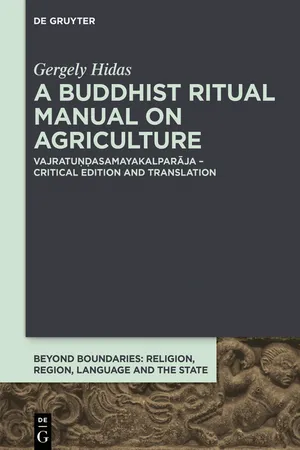
A Buddhist Ritual Manual on Agriculture
Vajratuṇḍasamayakalparāja – Critical Edition
- 152 pages
- English
- ePUB (mobile friendly)
- Available on iOS & Android
About This Book
This volume is the first in-depth study of a recently discovered Sanskrit dharani spell text from around the 5th century CE surviving in two palm-leaf and three paper manuscript compendia from Nepal. This rare Buddhist scripture focuses on the ritual practice of thaumaturgic weather control for successful agriculture through overpowering mythical Nagas. Traditionally, these serpentine beings are held responsible for the amount of rainfall. The six chapters of the Vajratundasamayakalparaja present the vidyadhara spell-master as a ritualist who uses mandalas, mudras and other techniques to gain mastery over the Nagas and thus control the rains. By subjugating the Nagas, favourable weather and good crops are guaranteed. This links this incantation tradition to economic power and the securing of worldly support for the Buddhist community.
Frequently asked questions
Information
1Previous research
1.1Primary references
1.2Secondary references
2Sources
2.1Sanskrit
2.2Chinese
2.3Tibetan
2.4Mongolian
2.5Commentaries, citations, parallels, auxiliary texts
3Structure
| [1] | Nāgahṛdayasya sasyapīḍākalpa – The Nāga Heart[-mantra] Ritual Manual for Crop Damage |
| [2] | Vaiśramaṇabhavanapraveśanāgasamaya nāma varṣaṇa-m-utsarga – The Sending forth of Rain, called Entry into the Residence of Vaiśramaṇa Nāga Vow21 |
| [3] | Mahāgaruḍavegavajravegajvālitagaruḍahṛdayamaṇḍalī nāma dhāraṇī – The Great Garuḍa Thrust Vajra Thrust Blazing Garuḍa Heart Ruler Dhāraṇī22 |
| [4] | Mūlamantravidhisopacāra – The Manual of the Root Mantra with the ... |
Table of contents
- Cover
- Title Page
- Copyright
- Contents
- Introduction
- 1 Previous research
- 2 Sources
- 3 Structure
- 4 Contents
- 5 Contexts
- 6 Practice
- 7 A critical edition
- Edition and translation
- References
- Index